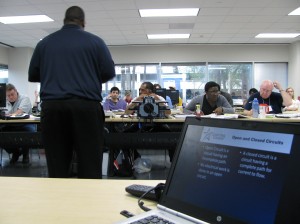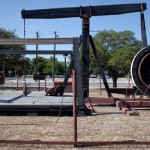Finding Oil, But Not the Skilled Workers
If you want to see where the best job prospects are, look who’s putting in the overtime. In Houston, the world’s energy capital where new finds in oil and gas are boosting the economy, it’s workers in manufacturing.
“Right now, the way we’re growing is we’re working people longer hours, the people who have the skills,” said Patrick Jankowski, an economist with the Greater Houston Partnership, a group that promotes the city’s businesses.
Thank the oil and gas industry’s drilling boom and its demand for pipes, valves and drilling equipment. It’s driving Houston’s manufacturing sector more than any single factor, according to the Partnership’s 2012 Employment Forecast.

Dave Fehling/StateImpact Texas
Manufacturing pipe and oil field equipment is boosting Houston's job market
Economist Jankowski crunched labor data and found that Houston workers in manufacturing are now putting in over 49 hours a week on average, up from 42 hours a week back in 2007. Jankowski told StateImpact that part of the reason is that companies are having a tough time hiring additional workers.
“There’s a skill mismatch and there’s a shortage in certain areas. And as strong as Houston’s economy is, the one thing that’s holding it back, we could deal with some more talent, we could deal with some more skilled workers,” said Jankowski.
Nowhere is that easier to see than at Houston-area community colleges: they’re scrambling to add fast-track training programs to meet the need.
“It’s absolutely huge. And right now, there’s no way we can meet that demand. The companies are lined up, looking for these skill sets,” said Joe Ed Bunton, a training program administrator at Lone Star College, a multi-campus community college in the Houston area with over 85,000 students.

Dave Fehling/StateImpact Texas
Learning electrical engineering in fast-track course at Houston's Lone Star College
Lone Star recently developed an Energy and Manufacturing Institute. One class StateImpact visited is called “Fast Track Engineering Assistant”. The class is held in a suburban mid-rise office building once used by Compaq Computer (now HP). The 20 or so students range in age from just-out-high-school to mid-career and are surrounded by desktop computers, big circuit boards, and other electrical gear.
What may be surprising is how many of the students have already completed college. Over a third of the students raised their hands when asked if they had a college degree.So why are they back in class?
“I have related experience but it’s not specific to what we’re working on right now. So this is going to fill in some gaps for me personally,” said Stacy Martin, one of the students.
Martin said the course gives them specific skills in high demand by big, oil services companies that are ready to hire them.
“It’s definitely going to increase my potential to hopefully get employed,” Martin said.
The course is special: students attend it tuition-free and companies that agree to take on graduates are reimbursed for hiring the students as apprentices for their first year. Who pays? The federal government. The course is made possible by a federal grant under what’s called the Wagner-Peyser program.
It’s just part of the federal funding helping community colleges at a time when the colleges say state funding isn’t keeping up with soaring enrollment.
According to calculations provided to StateImpact by the Texas Association of Community Colleges (see doc below), enrollment statewide surged 20% last year. But with cuts in state funding enacted by the Texas legislature, the effective amount of funding per student has plummeted 25%. It follows a trend of less and less proportional funding from the state, according to the association.
“The (local school districts) are suffering worse I’d say than the community colleges, but the community colleges have been cut. The only saving grace is we have tuition in addition to state and local taxes,” said Linda Head, Lone Star College’s associate Vice Chancellor.
Head said at a time when industry is begging for skilled workers, Texas needs to ensure the training is there.
“There is very little money that pays for facilities or equipment. So yes, (lawmakers) need to pay more attention if we’re going to attract and retain major employers in our state. Community colleges are there with programs ready-to-go to train the workforce they need. But we need the funding for programs like this,” said Head.
The Texas Workforce Commission (TWC) runs a “Skills Development Fund” targeted at just such programs. Its annual report shows state and federal funds for grants have doubled since 2008, most recently boosted in 2010 by increased state funds totaling $40 million and $10 million in federal stimulus money. A spokesperson for the TWC did not respond to emails from StateImpact Texas.
“Everyone always wants more funding,” said Chara McMichael. She’s chief of staff for Rep. Randy Weber, a Republican from Pearland.
Weber is one state lawmaker credited with pushing development of “vocational” training.
Weber didn’t respond to a request for an interview but McMichael said her boss has pushed for more vocational training at the high school level, something that has been out of vogue for years in public schools.
“It’s a fairly new revelation, a shift in the mindset that not everyone is going to a four year university,” said McMichael.
How State Funding for Community Colleges is Changing:

